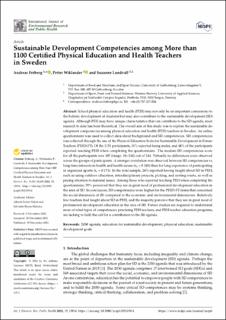| dc.description.abstract | School physical education and health (PEH) may not only be an important cornerstone to the holistic development of students but may also contribute to the sustainable development (SD) agenda. Although PEH may have unique characteristics that can contribute to the SD agenda, most research to date has been theoretical. The overall aim of this study was to explore the sustainable development competencies among physical education and health (PEH) teachers in Sweden. An online questionnaire was used to collect data about background and SD competencies. SD competencies was collected through the use of the Physical Education Scale for Sustainable Development in Future Teachers (PESD-FT). Of the 1153 participants, 31% reported being males, and 48% of the participants reported teaching PEH when completing the questionnaire. The median SD competencies score for all the participants was 105 (range: 18–144) out of 144. Virtually no differences were observed across the groups of participants. A stronger correlation was observed between SD competencies vs. long-time interests in health and health issues (rs = 0.343) than for long experience of participating in organized sports (rs = 0.173). In the total sample, 26% reported having taught about SD in PEH, such as using outdoor education, interdisciplinary projects, picking, and sorting waste, as well as paying attention to material issues. Among those who reported teaching PEH when completing the questionnaire, 70% perceived that they are in great need of professional development education in the area of SD. In conclusion, SD competencies were higher for the PESD-FT items that concerned the social dimension of SD compared to the economic and environmental dimensions. Relatively few teachers had taught about SD in PEH, and the majority perceive that they are in great need of professional development education in the area of SD. Future studies are required to understand more of what types of competencies practicing PEH teachers, and PEH teacher education programs, are lacking to fulfil the call for a contribution to the SD agenda.
Keywords: 2030 agenda; education for sustainable development; physical education; sustainable development goals | en_US |

